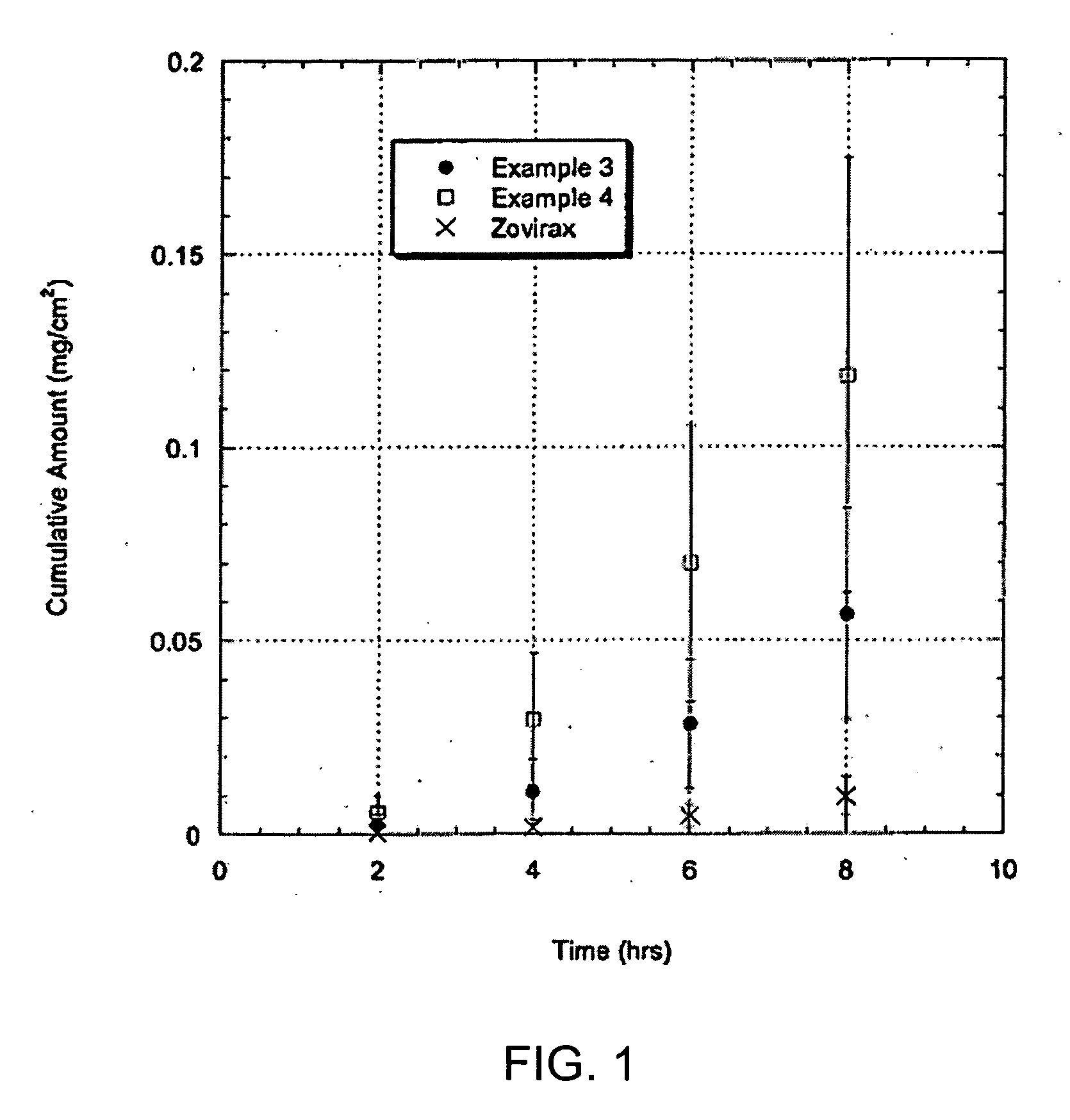Compositions and methods for dermally treating infections
a technology for dermal infections and compositions, applied in the direction of pharmaceutical delivery mechanisms, organic active ingredients, synthetic polymeric active ingredients, etc., can solve the problems of nausea, vomiting, diarrhea, nausea, vomiting, nausea, vomiting, etc., and achieve the effect of prolonging the release of drugs
- Summary
- Abstract
- Description
- Claims
- Application Information
AI Technical Summary
Benefits of technology
Problems solved by technology
Method used
Image
Examples
example 1
[0080] Hairless mouse skin (HMS) or human epidermal membrane (HEM) is used as the model membranes as noted for the in vitro flux studies described in herein. Hairless mouse skin (HMS) is used as the model membrane for the in vitro flux studies described in herein. Freshly separated epidermis removed from the abdomen of a hairless mouse is mounted carefully between the donor and receiver chambers of a Franz diffusion cell. The receiver chamber is filled with pH 7.4 phosphate buffered saline (PBS). The experiment is initiated by placing test formulations (of Examples 2-5) on the stratum corneum (SC) of the skin sample. Franz cells are placed in a heating block maintained at 37° C. and the HMS temperature is maintained at 35° C. At predetermined time intervals, 800 μL aliquots are withdrawn and replaced with fresh PBS solution. Skin flux (μg / cm2 / h) is determined from the steady-state slope of a plot of the cumulative amount of permeation versus time. It is to be noted that human cadave...
example 2
[0081] Formulations of acyclovir in various non-volatile solvent systems are evaluated. Excess acyclovir is present.
[0082] The transdermal flux of acyclovir from the test formulations through HMS is presented in Table 1 below.
TABLE 1Skin Flux*Non-volatile solvent system(mcg / cm2 / h)Isostearic Acid 0.1 ± 0.09Isostearic Acid + 10% Trolamine2.7 ± 0.6Isostearic Acid + 30% Trolamine7 ± 2Olive Oil0.3 ± 0.2Olive Oil + 11% Trolamine3 ± 3Olive Oil + 30% Trolamine0.3 ± 0.2Oleic Acid0.4 ± 0.3Oleic Acid + 10% Trolamine3.7 ± 0.5Oleic Acid + 30% Trolamine14 ± 5 Ethyl Oleate0.2 ± 0.2Ethyl Oleate + 10% Trolamine0.2 ± 0.2
*Skin flux measurements represent the mean and standard deviation of three determinations. Flux measurements reported were determined from the linear region of the cumulative amount versus time plots. The linear region was observed to be between 4-8 hours.
As indicated, significant enhancement of acyclovir skin flux is achieved with isostearic acid or oleic acid mixed with trolami...
examples 3-6
[0083] Prototype adhesive solidifying formulations are prepared as follows. Several acyclovir solidifying formulations are prepared in accordance with embodiments of the present invention in accordance with Table 2, as follows:
TABLE 2Example3456% by weightEthanol21252829.5Eudragit RL-PO*15182021.0Isostearic Acid31363942.0Trolamine3018104.7Acyclovir3332.8
*degussa polymer.
In Examples 3-6, the compositions in Table 2 are prepared as follows. Eudragit RL-PO and ethanol are combined in a glass jar and heated with stirring until the RL-PO is dissolved. The isostearic acid and trolamine is added to the RL-PO / ethanol mixture and the mixture is vigorously stirred. Once a uniform mixture is obtained, acyclovir is added to the mixture and the formulation is vigorously mixed.
PUM
| Property | Measurement | Unit |
|---|---|---|
| initial viscosity | aaaaa | aaaaa |
| initial viscosity | aaaaa | aaaaa |
| thickness | aaaaa | aaaaa |
Abstract
Description
Claims
Application Information
 Login to View More
Login to View More - R&D
- Intellectual Property
- Life Sciences
- Materials
- Tech Scout
- Unparalleled Data Quality
- Higher Quality Content
- 60% Fewer Hallucinations
Browse by: Latest US Patents, China's latest patents, Technical Efficacy Thesaurus, Application Domain, Technology Topic, Popular Technical Reports.
© 2025 PatSnap. All rights reserved.Legal|Privacy policy|Modern Slavery Act Transparency Statement|Sitemap|About US| Contact US: help@patsnap.com

